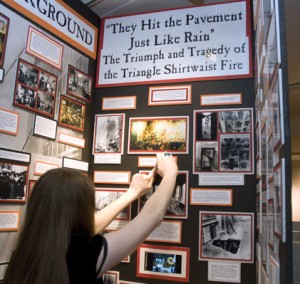As schools grapple with limited field trip budgets, museums are looking for new ways to engage with K-12 audiences. “Outreach” is the new buzzword.
If you are like me, you don’t have the people resources to engage in a full outreach program that includes school visits, new curriculum materials, and the like. With only three employees working on all our education and public programs, I needed to be strategic in how I went about developing an outreach program.
 Enter National History Day. If you aren’t familiar with this school-based academic program, check it out. Here’s a short summary right from the program website:
Enter National History Day. If you aren’t familiar with this school-based academic program, check it out. Here’s a short summary right from the program website:
“Students [in grades 6-12] choose historical topics related to a theme and conduct extensive primary and secondary research through libraries, archives, museums, oral history interviews and historic sites. After analyzing and interpreting their sources and drawing conclusions about their topics’ significance in history, students present their work in original papers, websites, exhibits, performances and documentaries. These products are entered into competitions in the spring at local, state and national levels where they are evaluated by professional historians and educators.”
NHD is a highly regarded program that helps students engage with history, but also teaches critical thinking and problem-solving skills, research and reading skills, oral and written communication and presentation skills, and self-esteem and confidence.
 Because it is an established program that operates in all 50 states, there is an opportunity for museums to get involved on many levels. For me, I decided to get involved as a district coordinator for Michigan History Day. My museum hosts one of the regional competitions each March. At the contest, over 200 students and their families spend a day at our museum. It’s a great way to introduce our resources to new audiences; most of the participants had never been to our museum before.
Because it is an established program that operates in all 50 states, there is an opportunity for museums to get involved on many levels. For me, I decided to get involved as a district coordinator for Michigan History Day. My museum hosts one of the regional competitions each March. At the contest, over 200 students and their families spend a day at our museum. It’s a great way to introduce our resources to new audiences; most of the participants had never been to our museum before.
If hosting a contest isn’t your thing, there are many other ways you can get your museum involved in National History Day.
- Volunteer as a judge at a district or state contest. It’s the best way to learn about the program and make connections with educators in your area.
- Make a list of historical resources in your archives or collections that you’d be willing to make available for student researchers. Post it on your website and send it to your state coordinator to get included on their list of resources.
- Work with your local district and state coordinators to plan a student research day in the fall.
- Partner with a local school that participates in NHD to serve as a mentor to their students. Review their research and final products and provide them guidance.
For more information on National History Day, check out the program website at: www.nhd.org.



